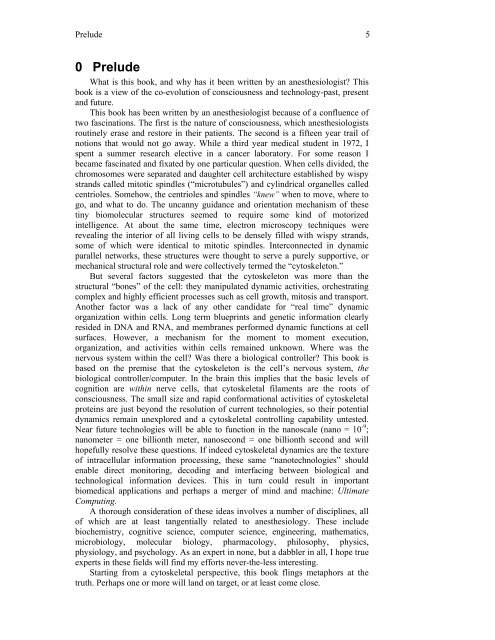ULTIMATE COMPUTING - Quantum Consciousness Studies
ULTIMATE COMPUTING - Quantum Consciousness Studies
ULTIMATE COMPUTING - Quantum Consciousness Studies
- No tags were found...
Create successful ePaper yourself
Turn your PDF publications into a flip-book with our unique Google optimized e-Paper software.
Prelude 5<br />
0 Prelude<br />
What is this book, and why has it been written by an anesthesiologist This<br />
book is a view of the co-evolution of consciousness and technology-past, present<br />
and future.<br />
This book has been written by an anesthesiologist because of a confluence of<br />
two fascinations. The first is the nature of consciousness, which anesthesiologists<br />
routinely erase and restore in their patients. The second is a fifteen year trail of<br />
notions that would not go away. While a third year medical student in 1972, I<br />
spent a summer research elective in a cancer laboratory. For some reason I<br />
became fascinated and fixated by one particular question. When cells divided, the<br />
chromosomes were separated and daughter cell architecture established by wispy<br />
strands called mitotic spindles (“microtubules”) and cylindrical organelles called<br />
centrioles. Somehow, the centrioles and spindles “knew” when to move, where to<br />
go, and what to do. The uncanny guidance and orientation mechanism of these<br />
tiny biomolecular structures seemed to require some kind of motorized<br />
intelligence. At about the same time, electron microscopy techniques were<br />
revealing the interior of all living cells to be densely filled with wispy strands,<br />
some of which were identical to mitotic spindles. Interconnected in dynamic<br />
parallel networks, these structures were thought to serve a purely supportive, or<br />
mechanical structural role and were collectively termed the “cytoskeleton.”<br />
But several factors suggested that the cytoskeleton was more than the<br />
structural “bones” of the cell: they manipulated dynamic activities, orchestrating<br />
complex and highly efficient processes such as cell growth, mitosis and transport.<br />
Another factor was a lack of any other candidate for “real time” dynamic<br />
organization within cells. Long term blueprints and genetic information clearly<br />
resided in DNA and RNA, and membranes performed dynamic functions at cell<br />
surfaces. However, a mechanism for the moment to moment execution,<br />
organization, and activities within cells remained unknown. Where was the<br />
nervous system within the cell Was there a biological controller This book is<br />
based on the premise that the cytoskeleton is the cell’s nervous system, the<br />
biological controller/computer. In the brain this implies that the basic levels of<br />
cognition are within nerve cells, that cytoskeletal filaments are the roots of<br />
consciousness. The small size and rapid conformational activities of cytoskeletal<br />
proteins are just beyond the resolution of current technologies, so their potential<br />
dynamics remain unexplored and a cytoskeletal controlling capability untested.<br />
Near future technologies will be able to function in the nanoscale (nano = 10 -9 ;<br />
nanometer = one billionth meter, nanosecond = one billionth second and will<br />
hopefully resolve these questions. If indeed cytoskeletal dynamics are the texture<br />
of intracellular information processing, these same “nanotechnologies” should<br />
enable direct monitoring, decoding and interfacing between biological and<br />
technological information devices. This in turn could result in important<br />
biomedical applications and perhaps a merger of mind and machine: Ultimate<br />
Computing.<br />
A thorough consideration of these ideas involves a number of disciplines, all<br />
of which are at least tangentially related to anesthesiology. These include<br />
biochemistry, cognitive science, computer science, engineering, mathematics,<br />
microbiology, molecular biology, pharmacology, philosophy, physics,<br />
physiology, and psychology. As an expert in none, but a dabbler in all, I hope true<br />
experts in these fields will find my efforts never-the-less interesting.<br />
Starting from a cytoskeletal perspective, this book flings metaphors at the<br />
truth. Perhaps one or more will land on target, or at least come close.






